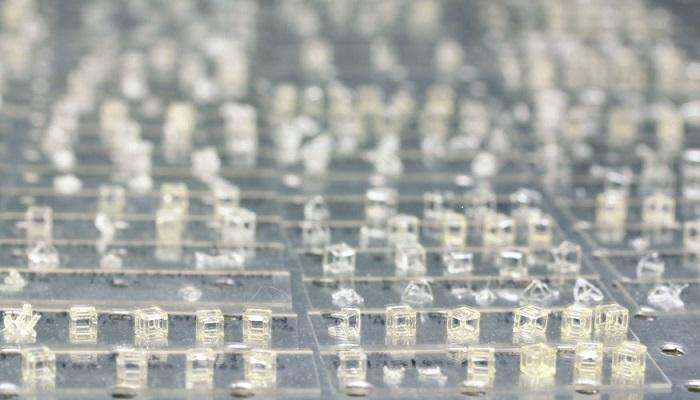Public Information Officer
- FMA
- The Fabricator
- FABTECH
- Canadian Metalworking
Our Publications
Categories
- Additive Manufacturing
- Aluminum Welding
- Arc Welding
- Assembly and Joining
- Automation and Robotics
- Bending and Forming
- Consumables
- Cutting and Weld Prep
- Electric Vehicles
- En Español
- Finishing
- Hydroforming
- Laser Cutting
- Laser Welding
- Machining
- Manufacturing Software
- Materials Handling
- Metals/Materials
- Oxyfuel Cutting
- Plasma Cutting
- Power Tools
- Punching and Other Holemaking
- Roll Forming
- Safety
- Sawing
- Shearing
- Shop Management
- Testing and Measuring
- Tube and Pipe Fabrication
- Tube and Pipe Production
- Waterjet Cutting
Industry Directory
Webcasts
Podcasts
FAB 40
Advertise
Subscribe
Account Login
Search
Laser-generated images print 3D parts in a flash
New additive manufacturing technology allows one-step printing of parts.
- By Jeremy Thomas
- December 11, 2018
- Article
- Additive Manufacturing

Volumetric 3D printing works by overlapping three laser beams that define an object’s geometry from three different directions, creating a 3D image suspended in a vat of resin. The laser light, which is at a higher intensity where the beams intersect, is kept on for about 10 seconds, enough time to cure the part.
Edited excerpt from a paper posted to the Lawrence Livermore National Laboratory website.
While additive manufacturing (AM) lets engineers and scientists build parts in configurations and designs never before possible, the impact of the technology has been limited by layer-based printing methods, which can take hours or days to build three-dimensional parts.
However, by using laser-generated, hologram-like 3D images flashed into photosensitive resin, researchers at Lawrence Livermore National Laboratory, along with academic collaborators, have discovered they can build complex 3D parts in a fraction of the time of traditional layer-by-layer printing. With this process, researchers have printed beams, planes, struts at arbitrary angles, lattices, and complex and uniquely curved objects in a matter of seconds.
The novel approach is called “volumetric” 3D printing.
“The fact that you can do fully 3D parts all in one step really does overcome an important problem in additive manufacturing,” said LLNL researcher Maxim Shusteff, the paper’s lead author. “We’re trying to print a 3D shape all at the same time. The real aim of this paper was to ask, ‘Can we make arbitrary 3D shapes all at once, instead of putting the parts together gradually layer by layer?’ It turns out we can.”
The way it works, Shusteff explained, is by overlapping three laser beams that define an object’s geometry from three different directions, creating a 3D image suspended in the vat of resin. The laser light, which is at a higher intensity where the beams intersect, is kept on for about 10 seconds, enough time to cure the part. The excess resin is drained out of the vat, and, seemingly, like magic, researchers are left with a fully formed 3D part.
The approach, the scientists concluded, results in parts built many times faster than other polymer-based methods, and most, if not all, commercial AM methods used today. Due to its low cost, flexibility, speed and geometric versatility, the researchers expect the framework to open a major new direction of research in rapid 3D printing.
“It’s a demonstration of what the next generation of additive manufacturing may be,” said LLNL engineer Chris Spadaccini, who heads Livermore Lab’s 3D printing effort. “Most 3D printing and additive manufacturing technologies consist of either a one-dimensional or two-dimensional unit operation. This moves fabrication to a fully 3D operation, which has not been done before. The potential impact on throughput could be enormous and if you can do it well, you can still have a lot of complexity.”
Click here to read the full article. The original paper appeared in the journal “Science Advances”, published online Dec. 8. A video of the process resides on YouTube.
About the Author
About the Publication
- Podcasting
- Podcast:
- The Fabricator Podcast
- Published:
- 04/16/2024
- Running Time:
- 63:29
In this episode of The Fabricator Podcast, Caleb Chamberlain, co-founder and CEO of OSH Cut, discusses his company’s...
- Trending Articles
- Industry Events
16th Annual Safety Conference
- April 30 - May 1, 2024
- Elgin,
Pipe and Tube Conference
- May 21 - 22, 2024
- Omaha, NE
World-Class Roll Forming Workshop
- June 5 - 6, 2024
- Louisville, KY
Advanced Laser Application Workshop
- June 25 - 27, 2024
- Novi, MI


























